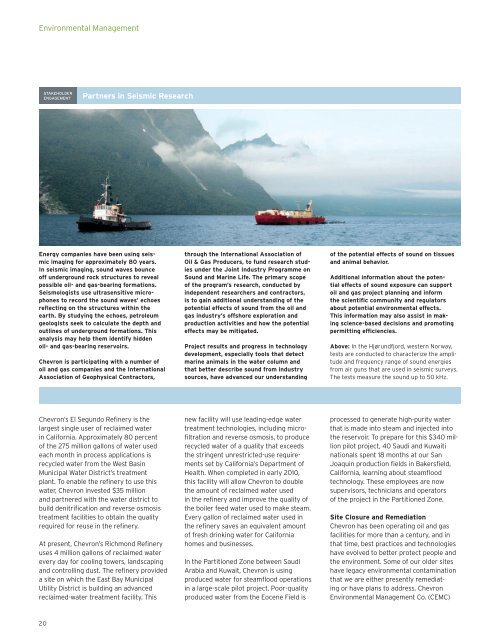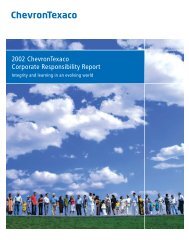Chevron Corporate Responsibility Report 2009
Chevron Corporate Responsibility Report 2009
Chevron Corporate Responsibility Report 2009
Create successful ePaper yourself
Turn your PDF publications into a flip-book with our unique Google optimized e-Paper software.
Environmental Management<br />
Stakeholder<br />
Engagement<br />
Partners in Seismic Research<br />
Energy companies have been using seismic<br />
imaging for approximately 80 years.<br />
In seismic imaging, sound waves bounce<br />
off underground rock structures to reveal<br />
possible oil- and gas-bearing formations.<br />
Seismologists use ultrasensitive microphones<br />
to record the sound waves’ echoes<br />
reflecting on the structures within the<br />
earth. By studying the echoes, petroleum<br />
geologists seek to calculate the depth and<br />
outlines of underground formations. This<br />
analysis may help them identify hidden<br />
oil- and gas-bearing reservoirs.<br />
<strong>Chevron</strong> is participating with a number of<br />
oil and gas companies and the International<br />
Association of Geophysical Contractors,<br />
through the International Association of<br />
Oil & Gas Producers, to fund research studies<br />
under the Joint Industry Programme on<br />
Sound and Marine Life. The primary scope<br />
of the program’s research, conducted by<br />
independent researchers and contractors,<br />
is to gain additional understanding of the<br />
potential effects of sound from the oil and<br />
gas industry’s offshore exploration and<br />
production activities and how the potential<br />
effects may be mitigated.<br />
Project results and progress in technology<br />
development, especially tools that detect<br />
marine animals in the water column and<br />
that better describe sound from industry<br />
sources, have advanced our understanding<br />
of the potential effects of sound on tissues<br />
and animal behavior.<br />
Additional information about the potential<br />
effects of sound exposure can support<br />
oil and gas project planning and inform<br />
the scientific community and regulators<br />
about potential environmental effects.<br />
This information may also assist in making<br />
science-based decisions and promoting<br />
permitting efficiencies.<br />
Above: In the Hjørundfjord, western Norway,<br />
tests are conducted to characterize the amplitude<br />
and frequency range of sound energies<br />
from air guns that are used in seismic surveys.<br />
The tests measure the sound up to 50 kHz.<br />
<strong>Chevron</strong>’s El Segundo Refinery is the<br />
largest single user of reclaimed water<br />
in California. Approximately 80 percent<br />
of the 275 million gallons of water used<br />
each month in process applications is<br />
recycled water from the West Basin<br />
Municipal Water District’s treatment<br />
plant. To enable the refinery to use this<br />
water, <strong>Chevron</strong> invested $35 million<br />
and partnered with the water district to<br />
build denitrification and reverse osmosis<br />
treatment facilities to obtain the quality<br />
required for reuse in the refinery.<br />
At present, <strong>Chevron</strong>’s Richmond Refinery<br />
uses 4 million gallons of reclaimed water<br />
every day for cooling towers, landscaping<br />
and controlling dust. The refinery provided<br />
a site on which the East Bay Municipal<br />
Utility District is building an advanced<br />
reclaimed-water treatment facility. This<br />
new facility will use leading-edge water<br />
treatment technologies, including microfiltration<br />
and reverse osmosis, to produce<br />
recycled water of a quality that exceeds<br />
the stringent unrestricted-use requirements<br />
set by California’s Department of<br />
Health. When completed in early 2010,<br />
this facility will allow <strong>Chevron</strong> to double<br />
the amount of reclaimed water used<br />
in the refinery and improve the quality of<br />
the boiler feed water used to make steam.<br />
Every gallon of reclaimed water used in<br />
the refinery saves an equivalent amount<br />
of fresh drinking water for California<br />
homes and businesses.<br />
In the Partitioned Zone between Saudi<br />
Arabia and Kuwait, <strong>Chevron</strong> is using<br />
produced water for steamflood operations<br />
in a large-scale pilot project. Poor-quality<br />
produced water from the Eocene Field is<br />
processed to generate high-purity water<br />
that is made into steam and injected into<br />
the reservoir. To prepare for this $340 million<br />
pilot project, 40 Saudi and Kuwaiti<br />
nationals spent 18 months at our San<br />
Joaquin production fields in Bakersfield,<br />
California, learning about steamflood<br />
technology. These employees are now<br />
supervisors, technicians and operators<br />
of the project in the Partitioned Zone.<br />
Site Closure and Remediation<br />
<strong>Chevron</strong> has been operating oil and gas<br />
facilities for more than a century, and in<br />
that time, best practices and technologies<br />
have evolved to better protect people and<br />
the environment. Some of our older sites<br />
have legacy environmental contamination<br />
that we are either presently remediating<br />
or have plans to address. <strong>Chevron</strong><br />
Environmental Management Co. (CEMC)<br />
20

















